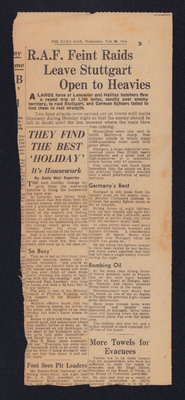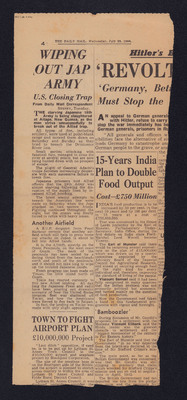RAF Feint Raids Leave Stuttgart open to Heavies
Title
RAF Feint Raids Leave Stuttgart open to Heavies
Description
A report on raids on Stuttgart and Donges. On the reverse is other news.
Creator
Date
1944-07-26
Temporal Coverage
Spatial Coverage
Language
Type
Format
One double sided newspaper cutting
Conforms To
Publisher
Rights
This content is available under a CC BY-NC 4.0 International license (Creative Commons Attribution-NonCommercial 4.0). It has been published ‘as is’ and may contain inaccuracies or culturally inappropriate references that do not necessarily reflect the official policy or position of the University of Lincoln or the International Bomber Command Centre. For more information, visit https://creativecommons.org/licenses/by-nc/4.0/ and https://ibccdigitalarchive.lincoln.ac.uk/omeka/legal.
Contributor
Identifier
NRobertsEJH170712-030001, NRobertsEJH170712-030002
Transcription
[underlined] THE DAILY MAIL, Wednesday, July 26, 1944 [/underlined]
R.A.F. Feint Raids Leave Stuttgart Open to Heavies
A LARGE force of Lancaster and Halifax bombers flew a round trip of 1,700 miles, mostly over enemy territory, to raid Stuttgart, and German fighters failed to find them in real strength.
Two feint attacks were carried out on towns well inside Germany during Monday night so that the enemy should be left in doubt until the last moment where the main blow was coming.
Mosquitoes were also sent to bomb Berlin – a sharp five-minutes attack in which many 4,000-pounders were used with great effect.
Stuttgart, a large industrial area, received more than 30,000 heavy incendiaries and a great load of high-explosives in a saturation attack lasting only 15 minutes.
This operation was much more hazardous than the attack on Kiel the previous night, which entailed only a small penetration of enemy territory.
Germany’s Best
Stuttgart is 300 miles from the nearest point on the enemy coast, so Bomber Command planned to mislead the enemy fighter packs as far as possible.
Strong forces of night fighters, now the best trained and most formidable arm of the Luftwaffe, were expected at points along any route that the bombers might take.
At some point flares went down and combats between bombers and fighters followed. A considerable number of fighter flares were dropped over Stuttgart while the attack was going on.
On the whole the fighters seemed to have been misled by our tactics, and many crews reported that they had not seen a single enemy aircraft during the night.
Bombing Oil
At the same time strong forces of heavy bombers went to France. One on the west coast bombed another oil depot at Donges, near St. Nazaire, and others attacked flying-bomb sites in the north.
Reconnaissance now shows that the attack on one of the oil depots at Donges the previous night caused great destruction.
Many large storage tanks were destroyed and smaller ones destroyed or damaged. Some tanks were still burning when the reconnaissance plane was over the target area.
The railway was also hit, and a tanker seemed to have capsized just off one of the quays.
[Article on housework, and partial articles on towels for evacuees and the chairman of the Mining Association meeting the president of the Yorkshire Mineworkers’ Association]
[page break]
[reverse of above newspaper cutting with articles on the Allies fighting the Japanese 18th Army in New Guinea, India’s food production being increased and Lytham St. Annes Town Council opposition of a new airport]
R.A.F. Feint Raids Leave Stuttgart Open to Heavies
A LARGE force of Lancaster and Halifax bombers flew a round trip of 1,700 miles, mostly over enemy territory, to raid Stuttgart, and German fighters failed to find them in real strength.
Two feint attacks were carried out on towns well inside Germany during Monday night so that the enemy should be left in doubt until the last moment where the main blow was coming.
Mosquitoes were also sent to bomb Berlin – a sharp five-minutes attack in which many 4,000-pounders were used with great effect.
Stuttgart, a large industrial area, received more than 30,000 heavy incendiaries and a great load of high-explosives in a saturation attack lasting only 15 minutes.
This operation was much more hazardous than the attack on Kiel the previous night, which entailed only a small penetration of enemy territory.
Germany’s Best
Stuttgart is 300 miles from the nearest point on the enemy coast, so Bomber Command planned to mislead the enemy fighter packs as far as possible.
Strong forces of night fighters, now the best trained and most formidable arm of the Luftwaffe, were expected at points along any route that the bombers might take.
At some point flares went down and combats between bombers and fighters followed. A considerable number of fighter flares were dropped over Stuttgart while the attack was going on.
On the whole the fighters seemed to have been misled by our tactics, and many crews reported that they had not seen a single enemy aircraft during the night.
Bombing Oil
At the same time strong forces of heavy bombers went to France. One on the west coast bombed another oil depot at Donges, near St. Nazaire, and others attacked flying-bomb sites in the north.
Reconnaissance now shows that the attack on one of the oil depots at Donges the previous night caused great destruction.
Many large storage tanks were destroyed and smaller ones destroyed or damaged. Some tanks were still burning when the reconnaissance plane was over the target area.
The railway was also hit, and a tanker seemed to have capsized just off one of the quays.
[Article on housework, and partial articles on towels for evacuees and the chairman of the Mining Association meeting the president of the Yorkshire Mineworkers’ Association]
[page break]
[reverse of above newspaper cutting with articles on the Allies fighting the Japanese 18th Army in New Guinea, India’s food production being increased and Lytham St. Annes Town Council opposition of a new airport]
Collection
Citation
Daily Mail, “RAF Feint Raids Leave Stuttgart open to Heavies,” IBCC Digital Archive, accessed July 27, 2024, https://ibccdigitalarchive.lincoln.ac.uk/omeka/collections/document/35233.
Item Relations
This item has no relations.


